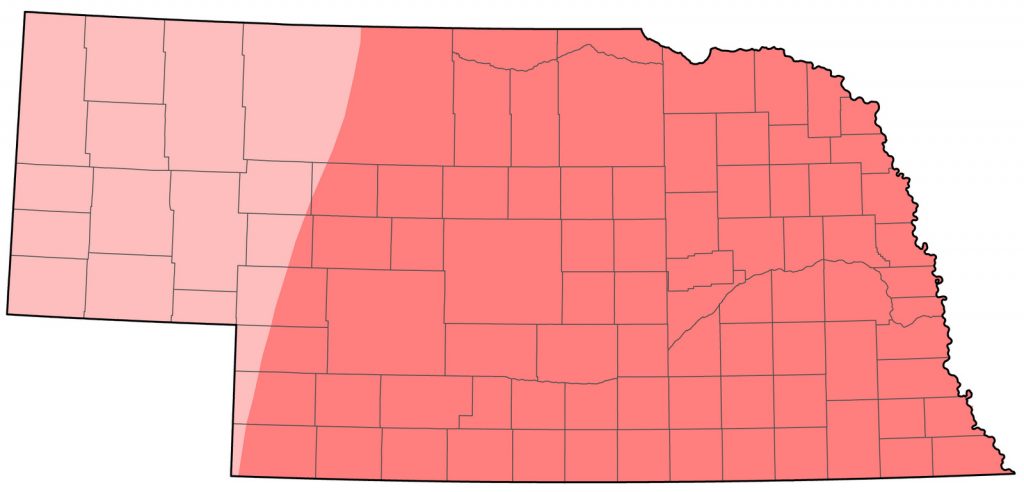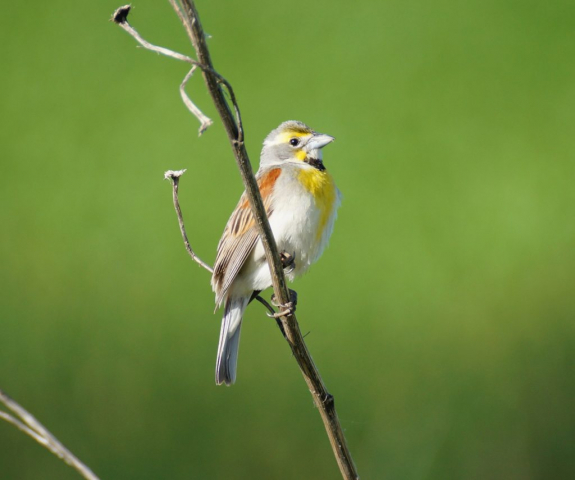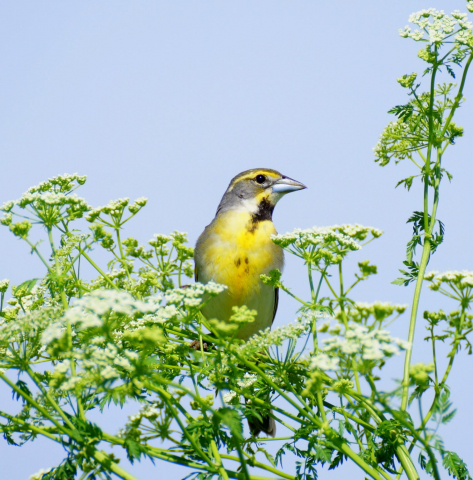Spiza americana
Status: Common regular spring and fall migrant east and central, locally common west. Common, locally abundant, regular breeder east and east-central, uncommon west-central and west. Rare casual winter visitor south and east.

Documentation: Specimen: UNSM ZM12132, 22 May 1895 Lancaster Co.
Taxonomy: No subspecies are recognized (AviList 2025).
Spring: Apr 28, 28, 28 <<<>>> summer (south and east); May 9, 9, 9 <<<>>> summer (north and west)
Earlier dates south and east are 8 Apr 2017 Douglas Co, 16 Apr 2024 Douglas Co, 16 Apr 2025 Jefferson Co, and 17 Apr 2007 Clay Co (see Winter).
An earlier date north and west is 6 May 2005 Garden Co.
Migrants arrive in late Apr, entering Nebraska via the southeast, and are less common in the Panhandle, where arrival is generally in late May and Jun (see Summer).
- High counts: 250 over Lincoln, Lancaster Co 14 May 2025, 100 at Spring Creek Prairie, Lancaster Co 30 May 2022, 76 in Sarpy Co on 13 May 1995, 55 in Johnson Co 22 May 2017, and 50+ in Otoe Co 17 May 2011.
Summer: Dickcissel is a common, locally abundant, breeder in the southeast, and common elsewhere east of the Panhandle. In the west, its abundance is variable from year to year, being common in some years and absent in other years. There is little information on historical occurrences in the west, but the few records suggest that occurrence there, including a few old breeding records, has always been variable (Ducey 1988, Bruner et al 1904). An old nest record was cited by Mollhoff (2022), a nest with eggs found by M. A. Carriker Jr. on Jim Creek, Sioux Co 26 Jun 1901 (UNSM ZM8957).
Major incursions into western Nebraska occurred in 2002, 2005, 2006, 2008, 2011, and to a lesser extent 2018, although 2018 was part of a dramatic increase in overall numbers in the decade 2014-2023; eBird reports 2004-2013 totaled 30, whereas in 2014-2023 there were an amazing 685 reports, most of which were from 2017-2023. The reasons for this rapid increase are not obvious, although increases from the mid-1980s to the late 2000s are supported by BBA data. Mollhoff (2016) showed the species occurred statewide during the second BBA period 2006-2011, including most of the incursion years listed above, but was largely absent from the southwestern Panhandle and northwestern Nebraska during the first BBA, 1984-1989 (Mollhoff 2001).
Western incursions are usually accompanied by statewide increases. In the 2008 incursion year, at the west edge of the expected range, Dickcissels were “everywhere” in Keith Co 17 Jun, where the observer surmised that wetter conditions allowed for more weeds, and “abundant” in Lincoln and Custer Cos where a BBS route recorded them at 25 of the 50 stops. A BBS route as far northwest as Crawford, Dawes Co had a count high of 12 on 5 Jul during the 2011 incursion year. In the 2006 incursion year, numbers were high in the core eastern range as well; 75 were counted in Cedar Co 21 Jun 2006 and point counts in a southeastern Nebraska Henslow’s Sparrow study area in 2006 (Silcock and Jorgensen 2007) yielded an estimated density of 80 Dickcissels per 100 acres.
Major incursions usually become apparent in the west in early Jun and consist almost entirely of unpaired males. Finck (1984) found that territorial display in Dickcissels functions in male-male competition for habitat rather than to attract females, suggesting that habitat availability is a factor in male distribution. Rosche (1982) indicated that he had “never observed a female nor any courtship or possible nesting activity,” and that singing males “often did not arrive until mid-Jun or even mid-Jul, sang for a week, and departed.” Of the surprising 30+ on a BBS route in Cheyenne Co 4 Jul 2009, most were males; only one pair was seen. Fretwell (1977) documented an unequal sex ratio in favor of males, which was thought to account for the many unpaired territorial males. Data from Kansas (Zimmerman 1982, Finck 1984) also showed this absence of mates for males occupying much of central and western Kansas. The arrival during incursion years of males in the west occurs about a month later than in the expected breeding range and reinforces the idea that these birds are unmated males; it has been suggested that Dickcissels may nest earlier in the southern portions of the breeding range and then shift northward, perhaps nesting a second time (Basili et al 1997).
BBS trend analysis (Sauer et al 2020) shows the species declined -0.55% annually (95% C.I. -1.32, 0.21) statewide 1966-2019.
Dickcissel nests are frequently parasitized by Brown-headed Cowbirds, a factor that limits Dickcissel reproductive success. Hergenrader (1962) found that 52.9% of the roadside nests he found in eastern and south-central Nebraska contained 1-3 cowbird eggs. Zimmerman (1982) found that in Kansas parasitism was significantly higher in grassland than in old fields and parasitism contributed significantly to lowered Dickcissel productivity in grasslands. Mollhoff (2022) noted 64% of nests had cowbird eggs, 50% of nests had equal or greater numbers of cowbird eggs than Dickcissel eggs, and 4% of nests had only cowbird eggs.
- Breeding phenology:
Copulation: 30 Jun-11 Jul
Nest-building: 18 May-2 Jul
Eggs: 19 May-18 Aug
Nestlings: 6 Jun-27 Sep
Fledglings: 17 Jun- 27 Jul
- High counts: 125 on a Thurston Co BBS route 18 Jun 1989, 122 in Johnson Co 13 Jun 2012, 100 at Branched Oak Lake, Lancaster Co 22 Jul 2017, 100 at Spring Creek Prairie, Lancaster Co 6 Jun 2020, 100 at Branched Oak Lake, Lancaster Co 18 Jul 2020, 100 at Kissinger Basin WMA, Clay Co 25 Jul 2020, and 94 in Hayes Co 9 Jun 2023.
Fall: summer <<<>>> Oct 3, 3, 5 (north and west); summer <<<>>> Oct 21, 22, 22 (south and east)
A later date north and west is 10 Oct 2009.
Later dates south and east are 26 Oct 2018 Douglas Co, 16 Nov 2010 Harlan Co, and 25 Nov 2004 Nuckolls Co. For Dec-Mar records see Winter.
Breeding locations are abandoned by the end of Aug, and most birds leave by early or mid-Sep.
Fall flocks are rare in Nebraska, despite the propensity of Dickcissels to form huge flocks during fall migration (Temple 2020), suggesting that such flocks form to the south of the state.
- High counts: 40 in southeast Sherman Co 4 Sep 2016, 40 at Jack Sinn WMA, Lancaster Co 1 Aug 2018, 35 at Hickory Ridge WMA, Johnson Co, 5 Aug 2016, 35 at Pawnee Lake, Lancaster Co 7 Aug 2018, 35 in Seward Co 23 Aug 2019, and 35 at North Lake Basin WMA, Seward Co 6 Aug 2024.
Winter: Reports of overwintering birds are of singles at feeders in the south and east, sometimes with House Sparrows. There are reports as far north as Wayne Co, in 1985-86 (Williams 1986). One was at a Bellevue, Sarpy Co feeder 15 Jan-29 Feb 1988 (Williams 1988) and another was at a Douglas Co feeder 10-17 Jan 1985 (Williams 1985).
Very late, possibly attempting to winter, were singles at a Bellevue feeder 11 Dec 2000, at Hastings, Adams Co 12 Dec 1925 (Jorgensen 2012), at Schilling WMA, Cass Co 15 Dec 2018, on the Grand Island CBC 16 Dec 1995, on the Lincoln CBC one photographed 15 Dec 2012, Harlan Co CBC one photographed 20 Dec 2015, at a Lancaster Co feeder 1-31 Dec 1984 (Williams 1985), and a bright male at Alma, Harlan Co 1 Jan 2000.
There are no Jan-Mar records (eBird.org, accessed Jan 2024).
Images
Abbreviations
BBA: Breeding Bird Atlas
BBS: Breeding Bird Survey
CBC: Christmas Bird Count
UNSM: University of Nebraska State Museum
WMA: Wildlife Management Area (State)
Literature Cited
AviList Core Team, 2025. AviList: The Global Avian Checklist, v2025. https://doi.org/10.2173/avilist.v2025.
Basili, G.D., S.L. Brown, E.J. Finck, D. Reinking, K.L. Steigman, S.A. Temple, and J L. Zimmerman. 1997. Breeding biology of Dickcissels across their range and over time. In Continental-scale ecology and conservation of the Dickcissel. Edited by G. D. Basili. Ph.D. dissertaiton, University of Wisconsin-Madison, Madison, Wisconsin, USA.
Bruner, L., R.H. Wolcott, and M.H. Swenk. 1904. A preliminary review of the birds of Nebraska, with synopses. Klopp and Bartlett, Omaha, Nebraska, USA.
Ducey, J.E. 1988. Nebraska birds, breeding status and distribution. Simmons-Boardman Books, Omaha, Nebraska, USA.
Finck, E.J. 1984. Male Dickcissel behavior in primary and secondary habitats. Wilson Bulletin 96: 672-690.
Fretwell, S.D. 1977. Is the Dickcissel a threatened species? American Birds 31: 923-932.
Hergenrader, G.L. 1962. The incidence of nest parasitism by the Brown-Headed Cowbird (Molothrus ater) on the roadside nesting birds in Nebraska. Auk 79: 85-88; reprinted NBR 30: 20-23.
Jorgensen, J.G. 2012. Birds of the Rainwater Basin, Nebraska. Nebraska Game and Parks Commission, Lincoln, Nebraska, USA.
Mollhoff, W.J. 2001. The Nebraska Breeding Bird Atlas 1984-1989. Nebraska Ornithologists’ Union Occasional Papers No. 7. Nebraska Game and Parks Commission, Lincoln, Nebraska, USA.
Mollhoff, W.J. 2016. The Second Nebraska Breeding Bird Atlas. Bull. Univ. Nebraska State Museum Vol 29. University of Nebraska State Museum, Lincoln, Nebraska, USA.
Mollhoff, W.J. 2022. Nest records of Nebraska birds. Nebraska Ornithologists’ Union Occasional Paper Number 9.
Rosche, R.C. 1982. Birds of northwestern Nebraska and southwestern South Dakota, an annotated checklist. Cottonwood Press, Crawford, Nebraska, USA.
Sauer, J.R., W.A. Link and J.E. Hines. 2020. The North American Breeding Bird Survey – Analysis Results 1966-2019. U.S. Geological Survey data release, https://doi.org/10.5066/P96A7675.
Silcock, W.R., and J.G. Jorgensen. 2007. Henslow’s Sparrow Status in Nebraska. NBR 75: 13-16.
Temple, S.A. 2020. Dickcissel (Spiza americana), version 1.0. In Birds of the World (A. F. Poole and F. B. Gill, Editors). Cornell Lab of Ornithology, Ithaca, NY, USA. https://doi.org/10.2173/bow.dickci.01.
Williams, F. 1985. Southern Great Plains Region. American Birds 39: 182-185.
Williams, F. 1986. Southern Great Plains Region. American Birds 40: 134-138.
Williams, F. 1988. Southern Great Plains Region. American Birds 42: 282-286.
Zimmerman, J.L. 1982. Nesting success of Dickcissels (Spiza americana) in preferred and less preferred habitats. Auk 99: 292-298.
Recommended Citation
Silcock, W.R., and J.G. Jorgensen. 2025. Dickcissel (Spiza americana). In Birds of Nebraska — Online. www.BirdsofNebraska.org
Birds of Nebraska – Online
Updated 24 Jul 2025


